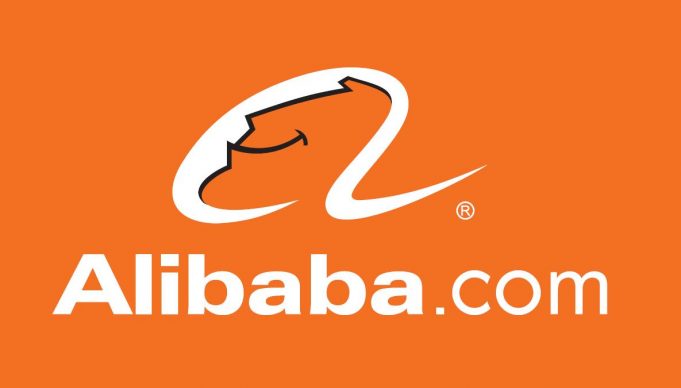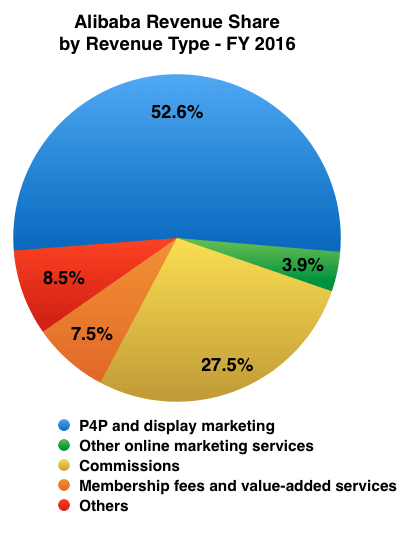Alibaba is the world’s largest online and mobile commerce company in terms of gross merchandise volume (GMV). Alibaba’s businesses are comprised of core commerce, cloud computing, mobile media and entertainment, and other innovation initiatives. The following diagram shows different businesses of Alibaba.
Alibaba generates over 90% of its revenues from its core commerce business. Alibaba’s core commerce business is comprised of marketplaces operating in retail commerce in China, wholesale commerce in China and international and cross-border commerce.
Retail commerce in China
Taobao Marketplace. Merchants on Taobao marketplace primarily are individuals and small businesses. Merchants can create storefronts and listings. This service is provided free of charge. Payment services through Alipay are also provided free of charge, unless payment is funded through a credit card. Alibaba makes money from merchants on Taobao from: (i) selling P4P (pay for performance) or display marketing services so that merchants can drive traffic to their websites (ii) third-party marketing affiliate fees to acquire additional traffic (iii) selling advanced storefront software to merchants that helps them to upgrade, decorate, and manage their online storefronts.
Rural Taobao. Alibaba aims to increase consumption and commerce among 600 million people residing in rural China through Rural Taobao program. Alibaba has established service centers in villages where rural residents can buy and sell products with the help of service center operators. Rural Taobao program not only helps village residents to sell items directly to urban consumers, but also extends the reach of brands and manufacturers to China’s vast rural population.
Tmall. It is a marketplace for consumers to buy Chinese and International branded products. A large number of Chinese and International brands and retailers operate their own stores on the Tmall platform with a unique look and feel. Alibaba makes money from merchants on Tmall from: (i) commissions based on pre-determined percentage of transaction value that varies by product category, typically ranging from 0.4% to 5.0%. (ii) annual upfront service fees (iii) online marketing services (iv) third-party marketing affiliates (v) storefront software.
Juhuasuan. It is a sales and marketing platform for flash sales. It helps Taobao and Tmall marketplace merchants acquire new customers through special discounts and promotional events. Alibaba makes money from Juhuasuan from: (i) commissions based on a predetermined percentage of transaction value generated from Juhuasuan (ii) placement fee for promotional slots for a specified period.

Wholesale commerce in China
1688.com. The wholesale marketplace matches wholesale buyers and sellers in categories such as general merchandise, apparels, electronics, raw materials, industrial components, and agricultural and chemical products. Listing items on 1688.com is free. Alibaba makes money from selling: (i) China TrustPass membership for an annual subscription fee to host premium storefronts with access to data-analytics applications and upgraded storefront management tools (ii) additional services, such as premium data analytics and online marketing services.
International and cross-border commerce
AliExpress. It is global marketplace targeting consumers from around the world to buy directly from manufacturers and distributors in China. Alibaba makes money from AliExpress by charging merchants a transaction commission, which is typically 5% of transaction value. Alibaba also makes money on AliExpress from third-party marketing affiliate program services and P4P marketing services.
Tmall Global. It is a platform within the Tmall for overseas brands and retailers to reach Chinese consumers without the need for physical operations in China.
Alibaba.com. It is the China’s largest wholesale marketplace for global trade. Alibaba makes money by selling: (i) annual Gold Supplier membership to host a premium storefront with product listings on the marketplace (ii) upgraded membership package to receive value-added services such as upgraded storefront management tools and P4P marketing services.
Lazada. Alibaba acquired a controlling stake in Lazada, a leading eCommerce platform in Southeast Asia, in April 2016. Lazada operates eCommerce platforms in Indonesia, Malaysia, the Philippines, Singapore, Thailand, and Vietnam.

Other Businesses
In addition to core commerce business, Alibaba also generates revenues from Alibaba Cloud and Mobile media and entertainment businesses.
Alibaba Cloud. Alibaba is the China’s largest provider of public cloud services. Alibaba Cloud offers a complete suite of cloud services including: elastic computing, database, storage and content delivery network, large scale computing, security, and management and application services. Alibaba charges fees that are primarily based on time and usage.
Mobile Media And Entertainment. Alibaba operates business in mobile media and entertainment through three distribution platforms, UCWeb mobile media, game publishing and multi-screen entertainment as well as content creation and production companies in film, music and sports.
Investee companies. Alibaba also participates in the logistics and local services sectors through investments in Cainiao Network and Koubei, respectively. In addition, Alibaba has a profit sharing interest in Ant Financial Services, the financial services group that operates through Alipay, the leading third-party online payment platform in China.
Alibaba Total Revenues and Profits – FY 2016
- Alibaba total revenues were $15.7 billion in FY 2016.
- The gross profits were $10.4 billion and gross profit margin was 66.0% in FY 2016.
- The operating profits were $4.5 billion and operating profit margin was 28.8% in FY 2016.
- The net profits were $11.1 billion and net profit margin was 70.7% in FY 2016. The net profits were higher than the operating profit because of $8.1 billion gain in the interest and investment income. The disposals of certain investments and businesses resulted in the gain.
Alibaba Businesses Revenues – FY 2016
Of the $15.7 billion of total revenues in FY 2016, Alibaba generated
- $12,412 million, 79.1% of the total, from China retail marketplaces.
- $665 million, 4.2% of the total, from China wholesale marketplaces.
- $342 million, 2.2% of the total, from International retail marketplaces.
- $841 million, 5.4% of the total, from International wholesale marketplaces.
- $468 million, 3.0% of the total, from cloud computing and Internet infrastructure.
- $958 million, 6.1% of the total, from Others.
Alibaba Revenues by Type of Service – FY 2016
Of the $15.7 billion of total revenues in FY 2016, Alibaba generated
- $8,248 million, 52.6% of the total, from P4P and display marketing.
- $615 million, 3.9% of the total, from other online marketing services.
- $4,310 million, 27.5% of the total, from commissions.
- $1,183 million, 7.5% of the total, from membership fees and value-added services.
- $1,330 million, 8.5% of the total, from Others.
A brief description of each of these revenue types is as follows:
- Online marketing services. These consist of the following:
- P4P, or pay-for-performance, marketing services. Here, sellers bid for keywords that match product or service listings appearing in search or browser results on a cost-per-click (CPC) basis at the prices established by Alibaba online auction system.
- Display marketing services. Here, sellers bid for display positions on the relevant marketplaces or through their third-party marketing affiliates at fixed prices or prices established by their real-time bidding system on a cost-per-thousand impression (CPM) basis.
- Other online marketing services
- Taobaoke program. Here, sellers on Taobao marketplace and Tmall pay commissions to Alibaba based on a percentage of GMV for transactions settled through Alipay from users sourced from third-party marketing affiliates. Commissions on Taobaoke are set by the sellers and depend on the amount the seller is willing to pay to generate incremental sales through the affiliate channel.
- Placement services. Here, sellers pay placement fees to purchase promotional lots on the Juhuasuan marketplace for a specified period.
- Commission on transactions. In addition to purchasing online marketing services, sellers on Tmall and Juhuasuan also pay a commission based on a percentage of GMV for transactions settled through Alipay in the respective marketplaces. Alibaba also generates revenues from commissions on transactions over AliExpress.
- Membership fees and value added services. Revenue from 1688.com is primarily generated from the sale of China TrustPass memberships, which allow wholesalers to host premium storefronts, with access to basic data analytic applications and upgraded storefront management tools. Alibaba also offers them value-added services, such as premium data analytics. Revenue from Alibaba.com is primarily generated from the sale of gold supplier memberships on Alibaba.com, which allow wholesalers to host premium storefronts. Alibaba also offers them value-added services such as product showcase, custom clearance, value-added tax, or VAT, refund and other import/export business solutions.
- Other. Other revenue mainly represents revenue from cloud computing, revenue from other services provided by UCWeb and AutoNavi, storefront fees, SME Annual Fee received from Ant Financial Services and interest income generated from micro loans before the completion of the restructuring of Payment Services during the year ended March 31, 2015. Storefront fees is comprised of monthly subscription fees for Wangpu, Alibaba’s storefront software that includes a suite of tools that assist sellers in upgrading, decorating, and managing their storefronts.














